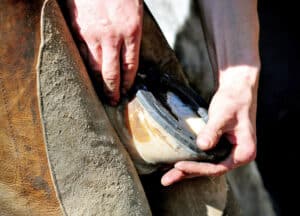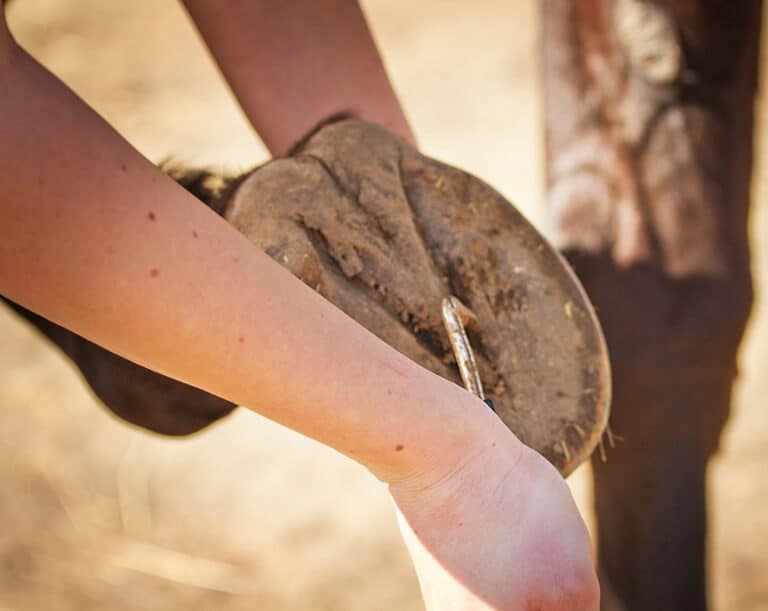Happy Feet
As the seasons change, so do your horses hooves. DR JENNIFER STEWART discusses strategies to help your horse’s feet during the long, hot days of summer.
Every season affects horses’ hooves differently – and summer can be especially challenging for feet. Hot, dry summer days can impact your horse enough to make you rethink your hoof care strategy.

Dry hooves
Even though the hoof wall appears hard and rigid to us, it is actually quite flexible! This allows the wall to expand and contract when the hoof hits the ground, dissipating the shock from landing. A flexible hoof is an essential part of healthy hoof dynamics, absorbing some of the concussion that would otherwise shoot straight up the leg and cause jarring in the tendons, joints and bones.
The hot and dry days of summer typically lead to dry hooves that can become contracted as the frog, bulb and the white line, which contain large amounts of water, dry out too. As the wall becomes brittle it loses the all-important flexibility, hoof expansion is compromised, shock absorption is reduced and stress through the lower leg increases.
Loss of elasticity in the wall changes the foot shape, how it impacts the ground and its ability to absorb shock. As the healthy tissue shrinks, open spaces develop, enabling infections to enter. Once elasticity is reduced, chips, splits and cracks can quickly appear and expand rapidly, destabilising the hoof wall. Added to this equation is the summer heat that bakes and compacts the ground so that it becomes rock-hard.
Cracks
Even small cracks greatly increase the chances of both drying and moisture absorption, and provide a pathway of entry for infection. They can stem from a variety of causes, including laminitis, trauma, repetitive concussion on a hard surface, or unbalanced feet. Vertical hoof cracks are common in horses with poor hoof care or those with excessively dry, shelly hooves. Maintaining the correct hydration level in the hoof and sole is vital, as a dry hoof wall is prone to shrinking and cracking, both of which can result in lost shoes, splits and lameness. Cracks are more common during dry weather and frequent changes from wet to dry conditions, if the toes are long or trimming too infrequent. Treatment depends on the cause and severity, but usually involves good nutrition and proper care by a farrier.

Bruises
In summertime, bruising to the hoof and frog commonly occur in horses working on hard, dry and stony ground, or from repeated leg stamping in response to flies. A horse with foot bruising is likely to be footsore or lame – especially on firm ground, and may start taking shorter strides or will be reluctant to walk on certain surfaces. If the hoof capsule has cracks, bacteria can enter and a bruise can turn into an abscess. When this happens, the horse will become acutely lame and may not weight bear on the affected foot. Whether your horse is shod or barefoot, regularly check his soles for bruising over the summer. Catching and helping to heal a sole bruise early on can head off a painful, slow-to-heal abscess.
Compacted soles
Day length plays a role in the growth of hooves and soles, which tend to grow faster in spring and summer, especially if the pasture is lush. The sole can begin to compact and look hard and shiny, especially if it can’t shed. Lack of hoof wear in soft, grassy pastures can result in the sole not shedding and your horse may look flat-footed if the sole becomes compacted. Compacted soles can increase the pressure in the hoof which may lead to bruising, abscessing and lameness.
Flaking soles and frogs
Most horses shed the frog at least twice a year. In response to hard, dry ground, soles and frogs build up a solid covering to protect from bruising, leading to taller hoof walls. When the excess sole tissue starts peeling and flaking in dry weather, the taller hoof becomes unprotected and unstable.
Hooves usually get plenty of moisture in spring and the hoof horn is supple and relatively soft. In summer, drier conditions stimulate harder, more dense horn. At the junction between the soft and hard horn, the frogs and soles can crack and peel. Increased frequency of farrier visits and trimming can help prevent horses from getting into trouble – speak with your farrier about ways to soften the tissue build up so it’s easier for them to remove.
Wet/dry cycles
When conditions fluctuate between wet and dry, hooves becomes stressed. Like a sponge, the hoof wall absorbs moisture quickly – and dries out quickly. Summer thunderstorms and rain, and moist, dew-soaked pasture during the night allow the hooves to soften and swell, but during the day when the ground is dry and hot, they dry out. Hosing horses down adds moisture to the hooves, riding on sand dries them out, and the type of stable bedding can also affect the hoof moisture balance. This cycle can cause nails to loosen as their holes in the wall enlarge, and suddenly you’ve got a horse who can’t keep shoes on.
Hard ground
This isn’t just a problem for hooves – concussive stress and strain from hard, compacted ground can cause a range of tendon, ligament and joint problems. Although the hoof-ground interaction is affected by many factors, including speed, keeping arenas damp and well-worked; avoiding hard, stony ground; hoof boots for barefoot horses; keeping the hoof balance correct; and more frequent farrier visits can all offer some protection from concussive forces.
Healthy hooves can better adapt to changing conditions. The impact of summer on hooves is always more profound than other seasons and horses that move nicely on soft winter ground can become uneven as the ground hardens in summer. Some horses with poor, thin soles or flat feet go well on moist, clay-based soils, but may go lame on sandy soils because of the pressure the sand puts on the sole.

Nutrition
Hoof condition is a reflection of nutrition. Slow growth, chipping, cracking, white-line crumbling and inability to hold shoes are not uncommon problems and although genetics and inadequate farrier care are often involved, improper diet can change a potential hoof issue into one that becomes a problem.
Diet imbalances or deficiencies aren’t the only factor in hoof abnormalities or problems – but they are a major cause. However, no single vitamin or mineral accounts for all these abnormalities. Nutrients required for optimum hoof health include essential amino acids, essential fatty acids, biotin, calcium, copper, lysine, manganese, phosphorus and zinc. Horses with access to pasture usually get enough essential fatty acids in their diet if they are not in work. Older horses and those with arthritis, or skin and hoof problems often benefit from supplementation with flaxseed or flax, canola, or other oils rich in omega 3 fatty acids.
If you spot a hoof problem, don’t assume the trouble lies just in the hoof and immediately reach for an over-the-counter supplement. No supplement can make up for a sub-standard diet and any supplement should be used wisely. Adding a scoop of this and that vitamin or mineral, or picking supplements that make claims to improve hoof quality may not provide all the nutrients needed to balance the diet and feed the feet.
And beware the overlapping that can occur when several feeds and supplements are used. This is especially important for zinc excesses, which are toxic to the gut flora and disrupt the biome. Keep it simple with good quality hay/pasture, clean water and a correctly formulated supplement, plus extra farriery care to maintain soundness, hoof health and integrity throughout the summer months.
Dr Jennifer Stewart BVSc BSc PhD is an equine veterinarian, CEO of Jenquine and a consultant nutritionist in Equine Clinical Nutrition.
All content provided in this article is for general use and information only and does not constitute advice or a veterinary opinion. It is not intended as specific medical advice or opinion and should not be relied on in place of consultation with your equine veterinarian.
This article was proudly brought to you by Omega Feeds. Super Food for Brilliant results! Redefine equine wellness this springtime with PONYPLUS with Omega Feeds. PONYPLUS is a low sugar, low starch feed that has been specifically formulated for easy keepers and horses/ponies with metabolic conditions. For more information go to omegafeeds.com.au and visit our EQ Health Hub.




